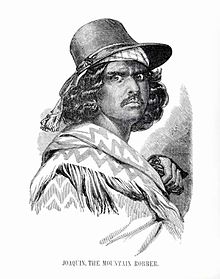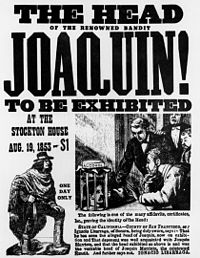- Joaquin Murrieta
-
Joaquin Carrillo Murrieta 
Artist's rendition of "Joaquin the Mountain Robber". Etching by Thomas Armstrong published in the Sacramento Union Steamer Edition on April 22, 1853Born c. 1829
Alamos, Sonora, Mexico or Quillota, ChileDied c. July 25, 1853
San Benito County, California?Cause of death Bullet wound Nationality Mexican or Chilean Other names The Robin Hood of El Dorado, The Mexican or Chilean Robin Hood Occupation Gold Miner, Outlaw Known for Outlawry during time period of California Gold Rush Spouse Rosa Feliz aka Rosita Carmela or Rosita Carmel Feliz Parents Joaquin and Rosalia (nee Carillo) Murrieta Relatives Jesus Murrieta (elder brother), Antonio Murrieta (brother), Rosa Murrieta (niece), Herminia Murrieta (niece), Anita Murrieta (niece), Ramon Feliz (Father-in-law),[1] Procopio (nephew) Joaquin Carrillo Murrieta (sometimes spelled Murieta or Murietta) (c. 1829 – c. July 25, 1853), also called the Mexican or Chilean Robin Hood or the Robin Hood of El Dorado, was a semi-legendary figure in California during the California Gold Rush of the 1850s. Depending on the point of view, he was considered an infamous bandit or a Mexican patriot.[2]
Contents
Controversy over his life
Controversy surrounds the figure of Joaquin Murrieta: who he was, what he did, and many of his life's events. This is summarized by the words of historian Susan Lee Johnson:
"So many tales have grown up around Murrieta that it is hard to disentangle the fabulous from the factual. There seems to be a consensus that Anglos drove him from a rich mining claim, and that, in rapid succession, his wife was raped, his half-brother lynched, and Murrieta himself horse-whipped. He may have worked as a monte dealer for a time; then, according to whichever version one accepts, he became either a horse trader and occasional horse thief, or a bandit."[2]
John Rollin Ridge, grandson of the Cherokee leader Major Ridge, wrote a dime novel about Murrieta; the fictional biography contributed to his legend, especially as it was translated into various European languages. A portion of Ridge's novel was reprinted in 1859 in the California Police Gazette. This story was picked up and subsequently translated into French. The French version, featuring a Chile-born Joaquín Murrieta, was translated into Spanish by Roberto Hynne. He claimed to have been in California during the Gold Rush and to have learned of Murrieta there.
Early life and education
The place of Murrieta's birth is disputed. Sources say that he was born in Álamos[2] in the northwestern state of Sonora, Mexico, or in Quillota, Chile (near Valparaiso).
Although biographical sources generally held that Murrieta was born in Chile or Mexico, a few reported that his mother's family were of mixed-Cherokee and Anglo-Protestant ancestry. Her family was said to have migrated to either Mexico or, questionably, Chile from the Southeastern United States and to have adopted European customs, such as private land ownership and a plantation system. (Note: The Cherokee were one of the Five Civilized Tribes in the Southeast United States and had adopted many European-American customs before the 1830s.) His mother was said to have married into the Murrieta family, which was connected to the colonial Spanish landed elite. Many scholars dispute the purported Murrieta-Cherokee ancestral connection.
Migration to California
By a fictional account that added to his legend, Murrieta reportedly went to California in 1849 to seek his fortune in the California Gold Rush. He encountered racism in the extreme competition of the rough mining camps. While mining for gold, he and his wife supposedly were attacked by American miners jealous of his success.[2] They allegedly beat him senseless, then raped and killed his wife. But, the source for these events is not considered reliable, as it was a dime novel, The Life and Adventures of Joaquin Murrieta, written by John Rollin Ridge and published in 1854.[2]
In contrast, the historian Frank Latta, in his twentieth-century book, Joaquín Murrieta and His Horse Gangs (1980), wrote that Murrieta had a criminal band made up of family and friends. Latta documented that they regularly engaged in illegal horse trade with Mexico, and had helped Murrieta kill at least six of the Americans who had attacked him and his wife.
He and his band attacked settlers and wagon trains in California. By 1853, the California state legislature considered Murrieta enough of a criminal to list him as one of the so-called "Five Joaquins" on a bill passed in May 1853. The legislature authorized hiring for three months a company of 20 California Rangers, veterans of the Mexican-American War, to hunt down "Joaquin Botellier, Joaquin Carrillo, Joaquin Muriata [sic], Joaquin Ocomorenia, and Joaquin Valenzuela," and their banded associates. On May 11, 1853, the governor John Bigler signed an act to create the "California State Rangers", to be led by Captain Harry Love (a former Texas Ranger and Mexican War veteran).
The state paid the California Rangers $150 a month, and promised them a $1,000 governor's reward if they captured the wanted men. On July 25, 1853, a group of Rangers encountered a band of armed Mexican men near Arroyo de Cantua near the Coast Range Mountains on the Tulare plains. In the confrontation, three of the Mexicans were killed. They claimed one was Murrieta, and another Manuel Garcia, also known as Three-Fingered Jack, one of his most notorious associates. Two others were captured.[3] A plaque (California Historical Landmark #344) near the intersection of State Routes 33 and 198 now marks the approximate site of the incident.
As proof of the outlaws' deaths, the Rangers cut off Three-Fingered Jack's hand and the alleged Murrieta's head and preserved them in a jar of alcohol to bring to the authorities for their reward.[2] Officials displayed the jar in Mariposa County, Stockton, and San Francisco. The Rangers took the display throughout California; spectators could pay $1 to see the relics. Seventeen people, including a Catholic priest, signed affidavits identifying the head as Murrieta's, alias Carrillo.[citation needed]
Love and his Rangers received the $1,000 reward money. In August 1853, an anonymous Los Angeles-based man wrote to the San Francisco Alta California Dailythat Love and his Rangers murdered some innocent Mexican mustang catcher and bribed people to swear out affidavits.[citation needed] Later that fall, California newspapers carried letters by a few men claiming that Capt. Love had failed to display Murrieta's head at the mining camps, but this was not true.[4] On May 28, 1854, the California State Legislature voted to reward the Rangers with another $5,000 for their defeat of Murrieta and his band.[5]
But, 25 years later, the myths began to form. In 1879, O. P. Stidger was reported to have heard Murrieta's sister say that the displayed head was not her brother's.[6] At around the same time, numerous sightings were reported of Murrieta as an old man. These were never confirmed. His preserved head was destroyed during the 1906 San Francisco Earthquake and subsequent fire.
Legacy
Murrieta's nephew, known as Procopio, became one of California's most notorious bandits of the 1860s and 1870s; he purportedly wanted to exceed the reputation of his uncle. Murrieta was possibly partly the inspiration for the fictional character of Zorro, the lead character in the five-part serial story, "The Curse of Capistrano", written by Johnston McCulley and published in 1919 in a pulp-fiction magazine. For some activists, Murrieta had come to symbolize resistance against Anglo-American economic and cultural domination in California. The "Association of Descendants of Joaquin Murrieta" says that Murrieta was not a "gringo eater", but "He wanted to retrieve the part of Mexico that was lost at that time in the Treaty of Guadalupe Hidalgo."[7]
Representations in media
Joaquin Murrieta has been a widely used romantic figure in novels, stories, and films, and on TV. Fiction and drama:
- The Life and Adventures of Joaquin Murrieta (1854) by John Rollin Ridge, published one year after Murrieta's supposed death. Parts of this were translated into French and Spanish, adding to his legend in Europe.
- Burns, Walter Noble (1932). The Robin Hood of El Dorado. New York: Coward-McCann, Inc..
- Fulgor y Muerte de Joaquín Murieta, (tr. The Splendor and Death of Joaquin Murieta), a play by Pablo Neruda, published in English in paperback in 1972.
- Звезда и смерть Хоакина Мурьеты (Zvezda i smert’ Khoakina Mur’ety — The Star and Death of Joaquin Murieta), 1976, by Alexei Rybnikov and Pavel Grushko, is based on Neruda's play.
- Daughter of Fortune, a 1999 novel by Isabel Allende, includes the mythical figure of Murrieta.
Film and TV:
- The Robin Hood of El Dorado 1936 film by William A. Wellman.[8]
- Stories of the Century, United States TV series, 1954-1954, episode "Joaquin Murrieta."
- Zorro (1957 TV series), United States TV series, 1957-1959
- The Mask of Zorro (1998) film features a youthful Murrieta and his death. His fictional brother Alejandro (Antonio Banderas) assumes the role of Zorro and kills Captain Love in revenge. Victor Rivers played Joaquin.[9]
Sports:
- Famously referenced by Ed Reed during halftime speech vs Florida State University
Music:
- "Así Como Hoy Matan Negros", recorded by Víctor Jara, based on Pablo Neruda and Sergio Ortega's collaboration Fulgor y Muerte de Joaquín Murieta.
- "Cueca de Joaquín Murieta" recorded by both Víctor Jara and Quilapayún, in the style of Chile's national dance, the cueca.
- "Premonición de la Muerte de Joaquin Murieta" (Premonition of the death of Joaquin Murieta), a tribute to Murrieta, performed by Quilapayún.
- "The Ballad of Joaquin Murrieta", performed by the Sons of the San Joaquin on the album Way Out Yonder.
- "The Bandit Joaquin" recorded by Dave Stamey
- "Murrietta's Head" written and recorded by Dave Alvin on the album Eleven Eleven
See also
- Tiburcio Vasquez
- Gregorio Cortez
- Procopio
References
- ^ Burns, Walter Noble, The Robin Hood of El Dorado Coward-McCann, Inc., New York, 1932.
- ^ a b c d e f *"Review: Roaring Camp: The Social World of the California Gold Rush", American Scholar, 1 January 2000, p. 142 Vol. 69 No. 1 ISSN: 0003-0937.
- ^ "California State Rangers". California State Military Museum. 1940. http://www.militarymuseum.org/CaliforniaStateRangers.html. Retrieved 2010-06-16.
- ^ Democratic State Journal, Oct. 17, 1853, Calaveras Correspondence from W. C. P. of Mokelumne Hill; San Joaquin Republican, Oct. 20, 1853, correspondence from Sonora, Tuolumne Co.
- ^ WPA, "California State Rangers: History", 1940, California State Military Museum, accessed 7 August 2011
- ^ See The Pioneer, Sat., Nov. 29, 1879. Also see History of Nevada County (Oakland : Thompson & West, 1880; rprt Berkeley: Howell-North Books, 1970), 115.
- ^ Bacon, David (December 15, 2001). "Interview with Antonio Rivera Murrieta". http://dbacon.igc.org/TWC/mm02_Murrieta.htm. Retrieved 2010-06-16.
- ^ Joaquin Murrieta at the Internet Movie Database
- ^ Joaquin Murrieta at the Internet Movie Database
Additional reading
- Paz, Ireneo (1904) (in Spanish). Vida y Aventuras del Mas Celebre Bandido Sonorense, Joaquin Murrieta: Sus Grandes Proezas En California (English translation by Francis P. Belle, Regan Pub. Corp., Chicago, 1925. Republished with introduction and additional translation by Luis Leal as Life and Adventures of the Celebrated Bandit Joaquin Murrieta: His Exploits in the State of California, Arte Publico Press, 1999. ed.). Mexico City.
- Susan Lee Johnson, Roaring Camp: The Social World of the California Gold Rush, New York: Norton.
External links
- Joaquín Murrieta, Picacho
- The Legend of Joaquin Murieta
- "Mystery of the decapitated Joaquin", Benicia News
- "Joaquin Murrieta", Biographic Notes, Inn-California
- [http://www.yosemite.ca.us/library/california_rangers/ Jill L. Cossley-Batt, The Last of the California Rangers, (1928)
- "What's the story on Joaquin Murieta, the Robin Hood of California?", Straight Dope
Categories:- Mexican outlaws
- Mexican folklore
- American folklore
- Mexican California
- California criminals
- Californios
- People from Quillota
- People from Álamos
- People of the California Gold Rush
- 1829 births
- 1853 deaths
- People in the colonial Southwest of North America
- Pleasanton, California
- American outlaws
- Latin American folklore
Wikimedia Foundation. 2010.

